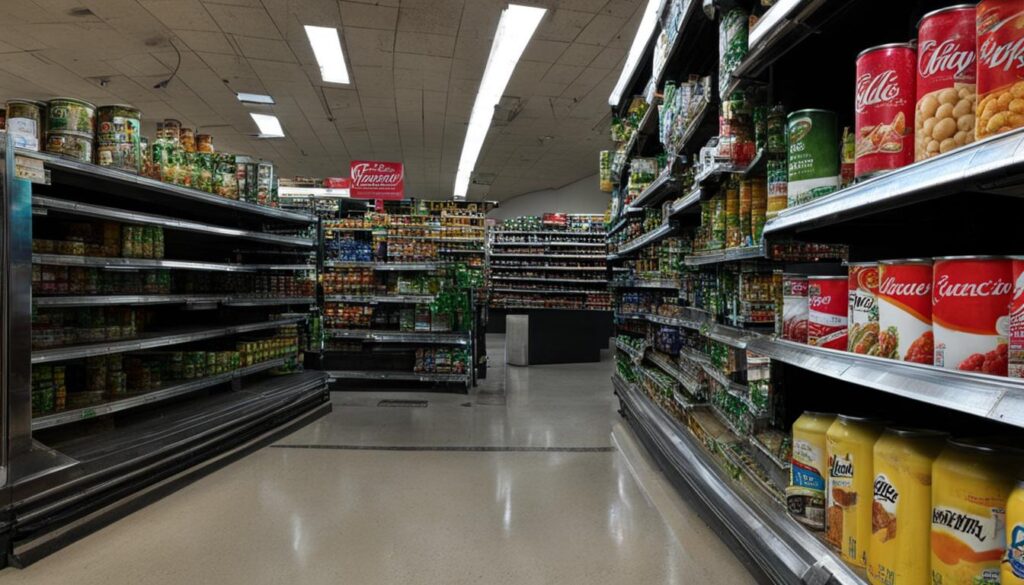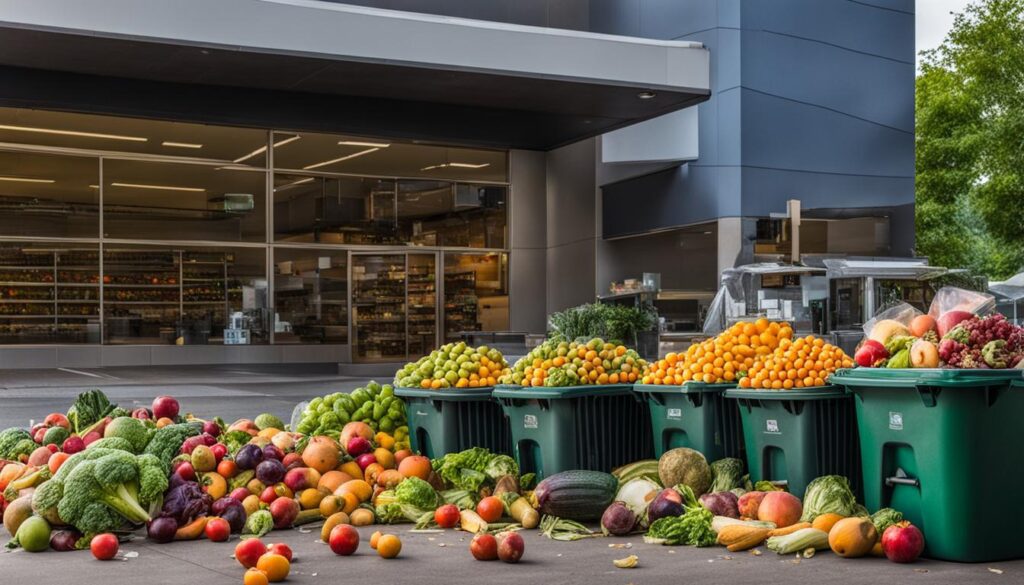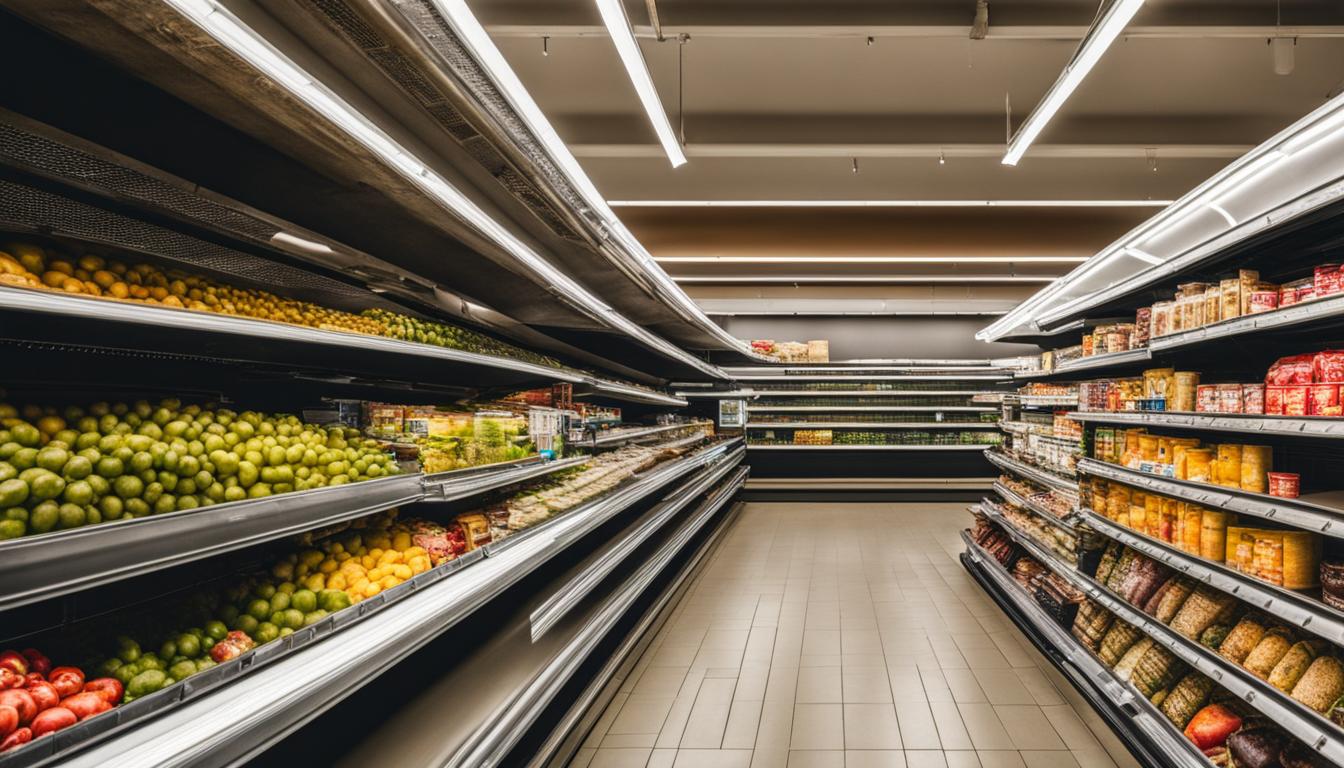Welcome to our informative guide on navigating food shortage in America. In this article, we will explore the pressing issue of food crisis and hunger in America, delve into the complexities of food insecurity, examine the challenges in the food supply chain and distribution, and provide valuable insights and tips to address this issue effectively.
According to recent reports, nearly 9 in 10 people facing hunger in America believe that food insecurity should be treated as an urgent crisis, despite the improving economy and lower unemployment rates. Factors such as inflation, high food prices, and limited access to grocery stores have further exacerbated this issue, making it crucial to prioritize dignity, increase access, expand opportunities, and improve health when addressing food shortage in America.
Throughout this article, we will discuss the impact of food shortage on individuals and communities, the root causes of this crisis, strategies to increase food access, innovations to alleviate the problem, the role of government initiatives, and building a sustainable and equitable food system.
Join us on this journey as we explore solutions, essential programs, and long-term strategies to combat food shortage in America. Together, we can overcome this challenge and create a more resilient and inclusive food system. So let’s dive in!
The Impact of Food Shortage in America
Food shortage in America has significant impacts on individuals and communities. The Feeding America report reveals that 88% of people facing hunger believe that the government should prioritize addressing this crisis. Factors such as poverty, unemployment, and limited access to affordable and nutritious food contribute to the issue. Rising food prices and inflation further exacerbate food insecurity, affecting the physical, mental, and economic well-being of individuals and families.
When food shortage occurs, it leads to increased hunger in America, leaving vulnerable populations at risk. Poverty and unemployment play a crucial role in limiting people’s access to adequate food. Without financial stability, individuals and families struggle to meet their basic needs, which includes having enough food on the table.
Furthermore, the lack of access to healthy food options aggravates the problem. Many low-income communities are food deserts, meaning they don’t have nearby grocery stores or supermarkets that offer fresh and nutritious food. This limits their choices to unhealthy, processed options that are often cheaper but lack proper nutritional value.
The increase in food prices and inflation also contribute to the food shortage crisis. As the cost of living rises, families find it harder to afford nutritious food. This forces them to make trade-offs, opting for cheaper, calorie-dense alternatives that may lack the essential nutrients needed for a balanced diet.
To visualize the impact of food shortage in America, consider the following statistics:
| Key Impact | Statistics |
|---|---|
| Families Facing Food Insecurity | Approximately 42 million people experience food insecurity in the United States, including 13 million children. |
| Health Effects | Food insecurity is linked to various health issues, including chronic diseases like diabetes and obesity. |
| Economic Burden | The healthcare costs associated with food-related health issues amount to billions of dollars annually. |
| Education Challenges | Food-insecure children are more likely to struggle academically and experience difficulties in concentrating and learning. |

The image above represents the struggles of hunger in America. It highlights the urgency to address food shortage and the impact it has on individuals and families.
As we delve deeper into the issue of food shortage in America, it becomes evident that comprehensive strategies and collaborative efforts across government, private sector, and communities are necessary to combat this crisis. The next section will explore various initiatives aimed at addressing the root causes of food shortage.
Addressing the Root Causes of Food Shortage
The Feeding America report sheds light on the critical importance of addressing the root causes of food shortage in America. To effectively combat this pressing issue and achieve long-term solutions, it is essential to tackle the underlying factors that contribute to food insecurity.
These root causes include:
- Poverty: Widespread poverty creates barriers to accessing an adequate and nutritious food supply. Many individuals and families struggle to afford basic necessities, including food.
- Unemployment: High levels of unemployment can significantly impact an individual’s ability to afford regular meals and maintain food security.
- Low wages: Insufficient wages make it difficult for individuals to afford nutritious food options, perpetuating the cycle of food shortage.
- Housing: High housing costs leave individuals and families with limited financial resources, forcing them to allocate a significant portion of their income to housing expenses rather than food.
- Healthcare: Limited access to affordable healthcare prevents individuals from addressing underlying health conditions that may contribute to food insecurity.
- Transportation: Lack of reliable and affordable transportation options can hinder individuals’ ability to access grocery stores or food assistance programs, particularly in rural and low-income areas.
- Systemic issues: Racial and economic disparities play a significant role in perpetuating food shortage in marginalized communities. Addressing systemic issues is crucial for creating equitable access to food.
To address these root causes effectively, it requires a comprehensive approach involving multiple stakeholders, including government agencies, community organizations, and private sectors. Policies must prioritize the well-being and economic stability of all individuals, focusing on strategies that promote affordable housing, job creation, healthcare accessibility, transportation infrastructure, and equal opportunities for all.
Creating a More Equitable Society
Eliminating food shortage in America is not just about ensuring enough food supply; it requires addressing systemic issues that perpetuate hunger and food insecurity. A society where everyone has equal access to nutritious food is a society that thrives.

Strategies to Increase Food Access
Improving food access is crucial to combat the food shortage in America. The Feeding America report highlights several strategies that can enhance access to nutritious food in low-income communities and alleviate food insecurity.
1. Increase funding for food assistance programs
The Emergency Food Assistance Program (TEFAP) is a vital resource for individuals and families facing food shortage. Increasing funding for programs like TEFAP can expand their capacity to provide nutritious meals to those in need.
2. Streamline eligibility processes
Improving the eligibility processes for food assistance programs can make it easier for individuals and families to qualify for and enroll in these programs. Simplifying the application process ensures that those who require support can access it more efficiently.
3. Expand community eligibility for school meal programs
Expanding community eligibility for school meal programs allows more students from low-income families to receive free or reduced-price meals. This step ensures that children have access to nutritious food, which can positively impact their health and educational outcomes.
4. Increase the availability of grocery stores
In areas where grocery stores are scarce, it is essential to increase their availability. Opening new grocery stores or renovating existing ones in low-income communities ensures that residents have convenient access to fresh and affordable food options.
5. Reduce food waste
Food waste is a significant issue contributing to the food shortage in America. Implementing measures to reduce food waste, such as improving inventory management and establishing partnerships with food recovery organizations, can help redirect surplus food to those in need.

| Strategy | Description |
|---|---|
| Increase funding for food assistance programs | Allocate more resources to programs like TEFAP to provide nutritious meals to individuals and families facing food shortage. |
| Streamline eligibility processes | Simplify the application process for food assistance programs to ensure efficient access for those in need. |
| Expand community eligibility for school meal programs | Allow more students from low-income families to receive free or reduced-price meals, improving both nutritional intake and educational outcomes. |
| Increase the availability of grocery stores | Open new grocery stores or renovate existing ones in low-income communities to provide convenient access to fresh and affordable food options. |
| Reduce food waste | Implement measures to minimize food waste, such as improving inventory management and establishing partnerships with food recovery organizations. |
Innovations to Alleviate Food Shortage
The Center for American Progress report highlights the importance of private sector innovations in addressing the food shortage in America. These innovations focus on various aspects, ranging from improving food access to leveraging technology and fostering collaboration within the food system.
Developing Food Access Solutions
Private sector innovations aim to develop targeted solutions that enhance food access for vulnerable populations. This involves implementing strategies such as mobile markets, community gardens, and pop-up grocery stores in underserved areas. By bringing food closer to those in need, these initiatives help alleviate food scarcity and improve overall food access.
Empowering Consumers to Make Healthier Choices
Private companies are playing a vital role in empowering consumers to make healthier food choices through innovative approaches. They are leveraging technology to provide personalized nutrition information, meal planning tools, and recipe suggestions. These solutions enable individuals to make informed decisions about their food consumption, promoting healthier eating habits and reducing the risk of food shortage-related health issues.
Connecting Consumers to Food Networks
Private sector innovations aim to bridge the gap between consumers and food networks to ensure the efficient distribution of resources. By leveraging technology platforms, such as mobile apps and online platforms, individuals can easily connect with local food banks, community kitchens, and other food assistance programs. This facilitates the distribution of surplus food, reduces wastage, and ensures that available resources reach those who need them most.
Utilizing Data Analytics to Understand Food Insecurity
Private companies are employing data analytics to gain insights into the underlying causes and patterns of food insecurity. By analyzing data related to demographics, socio-economic factors, and food consumption patterns, companies can identify areas of high need and develop targeted solutions accordingly. This data-driven approach maximizes the impact of private sector innovations in addressing food shortage in America.

Collaborations and Tailored Approaches
Private sector innovations foster collaborations among stakeholders across the food system, including farmers, retailers, NGOs, and government agencies. These collaborations enable the sharing of resources, knowledge, and best practices, fostering a comprehensive and sustainable approach to alleviate food shortage. Additionally, tailored approaches cater to the unique needs of different communities, considering factors such as cultural preferences and dietary requirements.
| Innovations | Description |
|---|---|
| Mobile Markets | Bringing fresh produce and essential food items to underserved areas through mobile trucks or vans. |
| Community Gardens | Creating communal spaces where individuals can grow their own food and cultivate a sense of community. |
| Pop-up Grocery Stores | Setting up temporary grocery stores in areas lacking access to traditional supermarkets, providing essential food items. |
| Nutrition Technology Apps | Developing mobile apps that provide personalized nutrition information, meal planning tools, and recipe suggestions. |
| Online Food Assistance Platforms | Creating online platforms that connect individuals in need with local food banks and community kitchens. |
| Data Analytics Solutions | Utilizing advanced analytics to gather insights on food insecurity patterns, enabling targeted interventions. |
Private sector innovations play a crucial role in addressing the food shortage in America. By developing targeted solutions, empowering consumers, utilizing technology, fostering collaborations, and leveraging data analytics, these innovations contribute to improving food access, affordability, and overall food system resilience.
The Role of Government Initiatives
Government initiatives play a crucial role in addressing food shortage in America. The United States Department of Agriculture (USDA) and federal programs like SNAP (Supplemental Nutrition Assistance Program) provide vital assistance to vulnerable populations, ensuring they have access to nutritious food. These programs act as a crucial safety net, helping individuals and families supplement their food budget during times of need.
However, it is imperative to recognize that there is still work to be done in terms of accessibility and service delivery. Policymakers need to prioritize funding for food safety net programs and streamline eligibility processes to ensure that those who require assistance can access it efficiently and without unnecessary barriers.
Addressing the underlying causes of food insecurity is also essential. By taking a comprehensive approach, government initiatives can work towards long-term solutions to combat food shortage in America. This involves tackling issues such as poverty, unemployment, and limited access to affordable and nutritious food.
A key aspect of government initiatives is the Federal Food Safety Net, a collection of programs designed to support individuals and families facing food insecurity. Let’s take a closer look at some of the programs that make up this safety net:
| Program | Description |
|---|---|
| SNAP | A federally-funded program that provides eligible low-income individuals and families with electronic benefit transfer (EBT) cards to purchase food. |
| The Emergency Food Assistance Program (TEFAP) | Distributes nutritious food to food banks, pantries, and soup kitchens, supporting organizations in providing meals to those in need. |
| National School Lunch Program (NSLP) | Ensures that children from low-income families have access to nutritious meals during the school day. |
| WIC (Women, Infants, and Children) | Provides low-income pregnant women, new mothers, and young children with nutrition education, healthy food, and support services. |
| Senior Farmers’ Market Nutrition Program (SFMNP) | Enables low-income seniors to purchase fresh fruits, vegetables, and other locally grown produce from authorized farmers’ markets. |
These programs, among others, form a crucial part of the broader government initiatives aimed at enhancing food security and reducing food shortage in America. By continuously improving and expanding these programs, the government can play an active role in ensuring that no individual or family goes hungry.
Building a Sustainable and Equitable Food System
Creating a sustainable and equitable food system is vital in addressing the food shortage in America. This requires a comprehensive approach that takes into account the impacts of climate change, promotes equitable access to healthy food options, and focuses on poverty alleviation. By investing in research and development, supporting local food initiatives, and integrating nutrition into healthcare, we can take significant steps towards building a more resilient and inclusive food system.
Climate change poses significant challenges to food production and availability. Rising temperatures, extreme weather events, and changing rainfall patterns can disrupt agricultural production, leading to food scarcity. To build a sustainable food system, it is crucial to implement practices that reduce greenhouse gas emissions, promote regenerative agriculture, and protect natural resources. By adopting sustainable farming methods, such as organic farming and agroforestry, we can mitigate the impacts of climate change and ensure a stable food supply for future generations.
Promoting Equitable Access to Healthy Food Options
Equitable access to healthy food is essential in combating food shortage and addressing food insecurity in America. Many communities, especially low-income areas and rural regions, lack grocery stores and fresh food markets, making it challenging for residents to access nutritious options. To overcome this barrier, it is important to support initiatives that increase the availability of affordable fruits, vegetables, and whole grains in underserved areas. This can be achieved through the establishment of farmers’ markets, mobile food markets, and community gardens that provide locally sourced and affordable produce to residents.
In addition to increasing access, it is crucial to focus on promoting education and awareness about healthy food choices. By providing nutrition education programs, cooking classes, and community workshops, individuals can learn the importance of incorporating nutritious foods into their diets. Empowering individuals with knowledge about healthy eating habits can lead to long-term improvements in their overall well-being and reduce the prevalence of diet-related diseases.
Addressing Poverty Alleviation
Poverty is a significant factor contributing to food shortage in America. Many individuals and families face financial constraints that prevent them from accessing an adequate and nutritious diet. To address this issue, it is important to implement poverty alleviation programs that provide economic support, job training, and educational opportunities to vulnerable populations. By addressing the underlying causes of poverty and income inequality, we can create a society in which everyone has the means to nourish themselves and their families.
Furthermore, supporting local food initiatives can play a crucial role in poverty alleviation. By investing in small-scale agriculture, community-supported agriculture programs, and urban farming projects, we can create employment opportunities and stimulate local economies. These initiatives not only provide access to fresh, locally sourced food but also contribute to the overall well-being of communities by promoting self-sufficiency and resilience.
By building a sustainable and equitable food system that addresses the impacts of climate change, promotes equitable access to healthy food options, and focuses on poverty alleviation, we can effectively combat the food shortage in America. It is a collective responsibility that requires collaboration between government, private sector organizations, and local communities. Together, we can create a future where everyone has access to nutritious and affordable food, ensuring the well-being and resilience of our society.
Conclusion
Addressing the food shortage crisis in America requires both immediate action and long-term strategies. By tackling the root causes of food insecurity, increasing access to nutritious food, fostering innovation, and prioritizing the well-being of all individuals, we can alleviate hunger and build a resilient food system.
Government actions play a critical role in implementing effective solutions. It is essential for policymakers to invest in food safety net programs, streamline eligibility processes, and take a comprehensive approach to addressing the underlying causes of food insecurity.
Private sector innovations also have a significant impact in combating the food shortage in America. Leveraging technology solutions, fostering collaborations, and tailoring approaches to specific populations can help improve food access and affordability.
Community collaborations cannot be overlooked either. By joining forces with local organizations, businesses, and residents, we can create impactful initiatives that address food shortage and establish sustainable long-term strategies.
It’s only through a collective effort that we can overcome the food shortage crisis in America, ensuring that no individual or community goes hungry. By implementing these strategies and working together, we can build a future where everyone has access to an abundant supply of nutritious food.
FAQs
How does food shortage in America impact individuals and communities?
Food shortage in America affects the physical, mental, and economic well-being of individuals and communities. It leads to hunger, malnutrition, and increased healthcare costs. Additionally, it can contribute to social and economic inequalities.
What are the root causes of food shortage in America?
The root causes of food shortage in America include poverty, unemployment, low wages, high housing costs, limited access to healthcare and transportation, and systemic issues like racial and economic disparities.
What strategies can be implemented to increase food access?
To increase food access, it is essential to expand funding for food assistance programs like The Emergency Food Assistance Program (TEFAP), improve eligibility processes, expand community eligibility for school meal programs, increase the availability of grocery stores, and reduce food waste.
How can private sector innovations help alleviate food shortage in America?
Private sector innovations can focus on developing food access solutions for targeted populations, empowering consumers to make healthier choices, connecting consumers to food networks, and creating data analytics to understand food insecurity and improve business practices.
What is the role of government initiatives in addressing food shortage in America?
Government initiatives, such as federal programs like the Supplemental Nutrition Assistance Program (SNAP) and the United States Department of Agriculture (USDA), provide assistance to vulnerable populations and supplement their food budget. However, there is room for improvement in terms of accessibility and service delivery.
How can we build a sustainable and equitable food system?
Building a sustainable and equitable food system requires addressing the impacts of climate change, promoting equitable access to healthy food options, and focusing on poverty alleviation. Investing in research and development, supporting local food initiatives, and integrating nutrition into healthcare are key steps toward achieving a resilient and inclusive food system.
What can be done to navigate and overcome the food shortage crisis in America?
To navigate and overcome the food shortage crisis in America, it is crucial to address the root causes of food insecurity, increase access to nutritious food, promote innovation, and prioritize the well-being of all individuals. Government actions, private sector innovations, and community collaborations all play vital roles in finding sustainable solutions.
Source Links
- https://www.feedingamerica.org/about-us/press-room/2023-Elevating-Voices-Insights-Report
- https://www.americanprogress.org/article/the-united-states-can-end-hunger-and-food-insecurity-for-millions-of-people/
- https://www.cicpindiana.com/new-research-unveils-areas-ripe-for-innovation-to-eliminate-food-insecurity/









